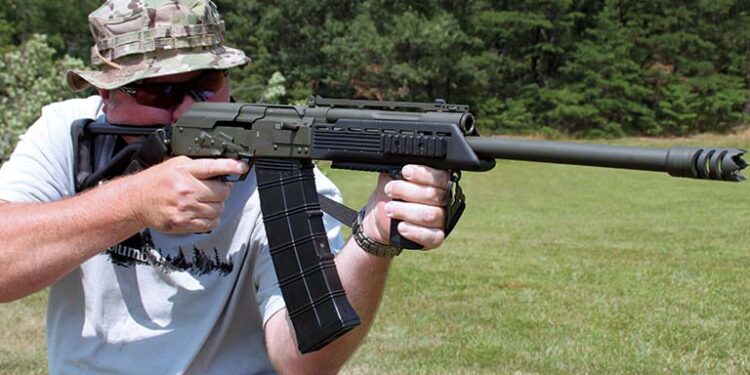By Todd Burgreen
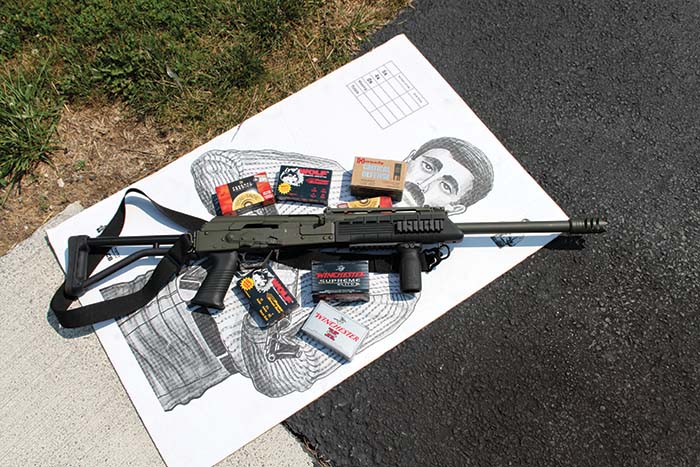
What long arm is typically found in the hands of civilian or even law enforcement in a potential personal defense encounter? Notice the use of the term “long arm” in the question. One would have to wager a shotgun is the most likely candidate. This is based on the shotgun’s simplicity, flexibility, reliability, price, and potency; especially considering ranges that typify personal defense situations. Yes, a shotgun can be viewed as limited in terms of range, but this is not necessarily a liability for civilians, LE and certain missions in the military where range is not an issue with a premium put on CQB stopping power.
The shotgun is a victim of its own reputation at times. Proponents speaking from what can be only labeled as ignorance would have you believe the shotgun is automatic death no matter the range with the weapon only needing pointing in the general direction of its intended target. Based on the above, gaining solid training and understanding it weaknesses and strengths is crucial. The misconceptions that the mere sound of a pump action’s slide being worked will send adversaries scurrying away needs dispelled. On the other side, detractors will label the shotgun as an outdated weapon that is only viable within 30 yards and has no ability to influence tactical situations beyond. The truth is somewhere in between as evident by the staying power of the shotgun in the law enforcement patrol cruiser and civilian go to weapon.
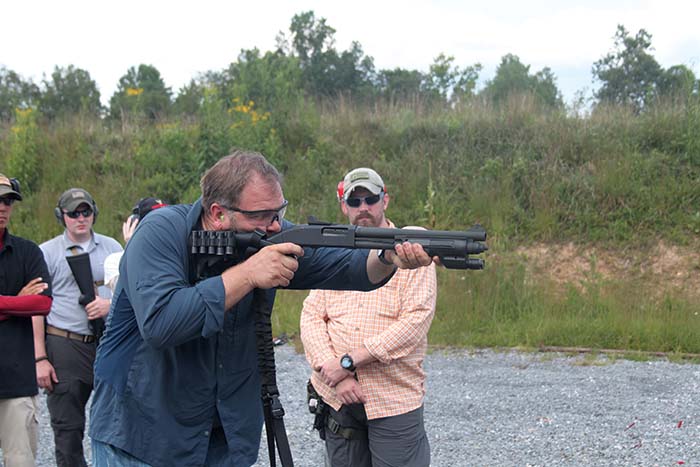
Recent attendance in a Graham Combat Shotgun course assisted in re-evaluating the shotgun. This was the third training experience with Matt Graham. It is rare indeed to attend numerous classes from the same trainer and yet feel like each is an entirely new experience. This is a credit to Graham’s method of instruction. Graham is imminently adaptable with total command of subject and breadth of experience to back it up. He does not impose a rigid syllabus on attendees playing only to his strengths; rather during his introduction he asks each student what they want out of the class. He then strives to provide this over a long day of training that spans 8 a.m. to 10 p.m. An important part of performing effectively in a tactical setting is an understanding of the basics of weapon manipulation and tactics. Graham goes to great lengths to explain this. Matt’s nuanced way of instruction extends all the way to the way he lists his courses on his website. He provides an overview of the course with little listed in terms of specific gear to use. This provides the student with an initial exercise of prioritizing what to bring to fulfill course. Graham thrives on adapting to environment and situation and wants to inculcate this as much as possible to his students.
Matt’s credentials, the ones he can report publically, lend legitimacy to his methods. Graham is a former police officer in Washington state and recipient of that state’s Medal of Honor. He served as a Federal Air Marshal being inspired to join the force after the 9/11 terrorist attack. Matt’s current “day job” is as a private contractor providing firearms and tactical instruction for the Department of Defense. He teaches many of the best operators in the world in small arms, tactics and combat mindset. Matt is not that well known outside of law enforcement and military training circles due to his 200 plus days of working for the Department of Defense. Thankfully, he has decided to expand into the private sector.
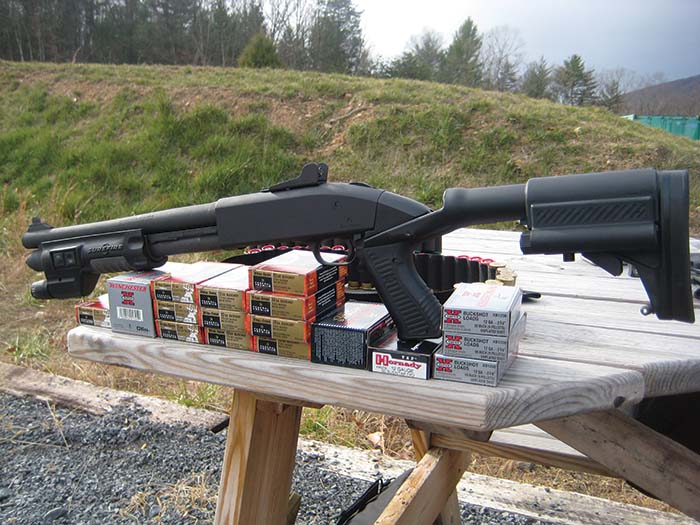
Graham Combat’s philosophy stresses the importance of mindset. Matt constantly emphasizes that an aggressive mindset supported by solid training is the key in surviving hostile encounters. Maxims such as shoot until the target is down illustrate this. Matt’s instruction technique is flexible allowing for analysis of a class’s strengths and weaknesses with extra attention to correcting weaknesses.
He treats each class as an opportunity to teach as much as possible to the attending students. Matt takes pride in addressing things that other courses overlook or assume as known. His demeanor of instantly embracing a class as a “band of brothers” puts everyone at ease allowing a smooth flow of information. This same demeanor hides an almost obsessive attention to detail methodology of instructing; this approach of building a solid skill set is so craftily done that the student is often unaware of it until a training exercise puts it to the test.
A word about gear used during the course. A fast paced course such as Graham Combat’s Shotgun Course is a great proving ground not only for the individual, but also for firearms and ancillary equipment. A failure with your weapon, shotgun in this case, only takes away from the learning experience. Based on this, it was chosen to bring a Mossberg 590A1 14 inch SBS and custom Saiga S12.
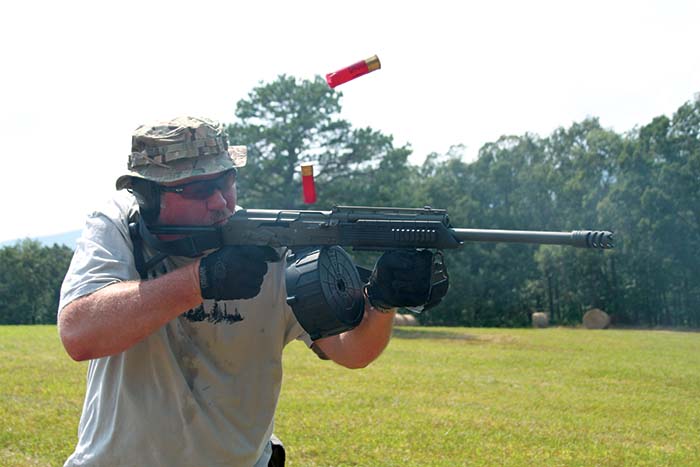
The Mossberg M590A1 is a pump-action 12 gauge combat shotgun with an alloy receiver, a bayonet lug and ghost-ring style sights on request. The 14-inch barrel Mossberg used in the Graham course did not possess the bayonet lug feature. The receiver of the M590A1 is of aircraft aluminum with the bolt locking into a steel barrel extension. The weapon is designed to facilitate maintenance under field conditions, with easy access to internal components. It has a removable end cap, spring and follower on the magazine for straight-through cleaning, and barrel removal is simple for detailed cleaning and maintenance. The receiver mounted safety is convenient for right or left-handed shooters; simply push the button forward and you’re ready to fire. In addition, the Mossberg 590A1 features an anti-jam elevator for reliable feeding and dual extractors for positive shot shell extraction/ejection.
The Mossberg 590A1 as it arrived had a generous recoil pad mounted on the “Speedfeed” stock. 12 gauge recoil is stout and anyone telling you different should be scrutinized. While recoil is not prohibitive and one gets accustomed to it, anything that reduces a combat shotgun’s recoil without effecting weapon handling should seriously be considered by anyone who spends time training or deploying the combat shotgun in the field. The BlackHawk’s Knoxx SpecOps recoil reducing stocks was chosen to mitigate recoil. It solves two of the biggest problems facing shotgun users – recoil and length-of-pull adjustability.
The Knoxx SpecOps incorporates two separate recoil-reduction devices. One system in the pistol grip that absorbs the majority of the recoil energy and a second one in the buttstock handles the rest. With the SpecOps stock the majority of the recoil is removed by the mechanism located inside the pistol grip, so there is no pain to the shooters hand or shoulder. BlackHawk literature states an 85% reduction in perceived felt recoil along with limiting muzzle climb allows faster follow-up shots if warranted or more than one adversary is encountered. The SpecOps is adjustable from a minimum of 11.25 inches to a maximum of 15.25 inches by pressing a lever and pulling or pushing the stock to the desired length a la the familiar AR-style collapsible buttstocks. This adjustability enables a better fit to individual shooters and adaptability if tactical vests or body armor are employed. The butt plate of the stock is highly textured to improve shooter control when the shotgun is mounted to the shoulder. The SpecOps stock comes with a sling swivel stud installed at the toe of the butt. In addition, there are two alternate sling mounting locations along with a slot through the stock to install a web sling. Only comment found worthy of making is that it would be nice if the Knoxx stock had provision for utilizing a single point sling in lieu of a two-point type.
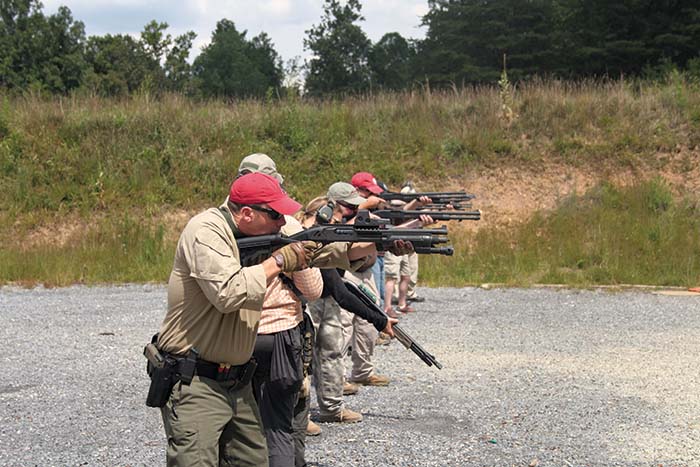
Another modification made to the Mossberg 590A1 was the addition of a Surefire weapon light forend; specifically the 621LF model due to the shorter 14 inch barrel and resultant shorter forend tube. Beware to specify the Surefire single battery light module as the double battery light assembly protrudes past the Mossberg’s muzzle negating the purpose of going the 14-inch barrel SBS route. The Surefire forend improves upon the Mossberg’s utility. It features a high-efficiency LED emitter that is virtually immune to failure since there’s no filament to burn out or break. Maximum output is 80 lumens, and it continues producing tactical-level light for over three hours. There are two separate switches integrated into the forend: a momentary-on pressure pad switch on the right side and a constant-on rocker switch on the left side. A molded-in polymer high-friction pad enhances grip in wet or cold conditions. The Mossberg 590A1’s pump action is simple, effective, and reliable. The manual pump-action operation allows for use of any ammunition type spanning the gamut from low brass shotshells to specialty breaching rounds.
The second shotgun used at the Graham Shotgun course was a Saiga S12 shotgun. The Saiga shotgun is modified to meet import requirements via sporter stock with no pistol grip. The heart of the Saiga shotgun is an AK operating system. The process to modify the Saigas back into the more familiar AK profile, albeit with much larger hole in the barrel, is well known and relatively straight forward process involving moving trigger guard forward to make room for pistol grip, replacing fire control group, and installing AK-type stock of choice. The Saiga S12 is all business with its 18-inch barrel, foldable rear stock, SAW-type pistol grip, and black synthetic forearm giving an overall length of 40.5 inches weighing 7.5 pounds empty. A Krebs safety lever is fitted to the S12 that features a manual bolt hold open notch in an effort to provide one possible solution to the Saiga magazine change conundrum.
The Saiga S12 shotgun requires a total change in operating method versus a tube fed shotgun. The S12 is fed via 5, 8, 10, or 12 round stick magazines along with drum magazines with capacities as high as 30 rounds. The S12 was used in the Graham Course with 10-round AGP stick magazines combined with high capacity drums from MD Arms and Alliance Armaments. The drums represent performance enhancement in a big way. The Saiga S12 is closer to an assault rifle in its manual of arms versus a tube fed shotgun.
The Saiga S12 has its own unique characteristics that need to be accepted for the most efficient use of the platform. The Saiga S12 does not have a last round hold open feature which complicates reloads, especially if magazines are topped off to capacity. The size of the 12 gauge rounds make full capacity magazines problematic to lock in place with the bolt forward. Different methods can be employed such as downloading magazines making it easier to compress the magazine’s spring. This is not preferred by many considering limited capacity of the stick magazines to begin with. Magazine changes were definitely different in nature; even if you are already familiar with the AK “rocking” method via rifles. The girth and weight of the Saiga magazines take time to get used to when performing reloads under speed compounded by the need to keep the Saiga’s bolt open allowing for the magazine insertion. A Kreb’s safety with bolt hold open notch proved a worthy addition to the S12 in this regard.
The Graham class was conducted at Echo Valley Training Center (EVTC). We started with the basics of presentation, loading, and engaging multiple targets. As most know, basics are the foundation that all must return to in order to maintain effectiveness. After all, “advanced” shooting methods are the basics done faster and better. Matt’s gift of instruction brought home the importance of grip and shouldering the shotgun in the most efficient manner. Matt showed how important it was to mount the shotgun toward the centerline of one’s body to control recoil enabling accurate hits and fast follow up shots. The Graham shotgun course progressed quickly from static positional shooting into firing on the move. How to move dynamically while remaining safe around fellow students was introduced and illustrated how Matt followed a building block of skills approach.
The Graham Combat course’s goal was to give attendees the skills to operate and survive in real world situations. Matt introduced basic self care methods including tourniquet use. A large portion of the medical evolution detailed different tourniquets and how to affix on oneself properly before turning to doing so on training partner. It is quickly evident that the effective application of the tourniquet is a key part of managing a traumatic injury. The use of the tourniquet has evolved over the last couple of decades by receding from prominence to now re-emerging as a life saving tool. Field dressing and wound packing was demonstrated and practiced as well, which is an important skill applicable in areas that a tourniquet is or is not used.
Graham drilled how to better operate the shotgun without being confined by traditional firing positions. Matt’s building block method of instruction was most effective here as well. A drill that Matt labeled as “Crazy 8s” took a student from standing to kneeling to sitting, and then to sides and back as he called out positions while engaging threat targets. This drill proved a precursor to the next training evolution. Matt arranged for EVTC to bring in a vehicle for use during the course. Matt’s logic is that the majority of law enforcement and civilians spend a large proportion of time with cars and thus must be comfortable in such an environment. The maximum amount of cover was stressed to minimize the shooters profile while still effectively engaging the target.
The Graham Combat course pace never slowed down with several training evolutions keeping students moving briskly. Matt proved capable of taking a group of relative strangers with a variety of experience and backgrounds and had us moving as teams under control while engaging multiple target areas. His immersion training allowed for the square range to transform into realistic scenario driven exercises with clear objectives. The crucial importance of communication, sound tactics, weapon manipulation skills, and discipline learned during the training is hard to deny.
Graham’s approach at instruction has a nuanced way of incorporating all of the different drills and techniques into a comprehensive skill set. Each shooter progressed rapidly in skills and confidence during the course. Too many items were covered during the intense day of training to be fully explained in a space constricted article. Along this same line of reasoning, there are items in the Graham training that must be personally experienced to fully grasp. For as many items listed in this article, there are just as many not mentioned due to space limitations.
Sites of Interest:
Matt Graham
www.grahamcombat.com
Echo Valley Training Center
www.echovalleytrainingcenter.com
| This article first appeared in Small Arms Review V18N1 (February 2014) |



